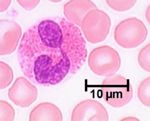More commonly referred to as white blood cells. They are formed by the process known as leukopoiesis. Leukocytes are sub divided into granulocytes and agranulocytes; granulocytes have a granular cytoplasm and polymorphic nuclei such as is seen in neutrophils, eosinophils, and basophils. Granulocytes function as part of the non specific natural immune response to infection and as part of the inflammatory response to tissue injury.
The agranulocytes include lymphocytes and monocytes. Lymphocytes differ from granulocytes and monocytes as they form part of the acquired immune response, dividing into B or T cells to fight attacks by foreign cells, bacteria and viruses. Monocytes leave the blood stream to enter tissues where they become macrophages, which engulf bacteria and tissue debris by phagocytosis.
The cells
">
|
Neutrophil ©RVC 2008 |
Lymphocyte ©RVC 2008 |
Eosinophil (Feline) ©RVC 2008 |
Monocyte (Canine) ©RVC 2008 |
|
Basophil (Equine) ©RVC 2008 |
Macrophage ©Nottingham Uni 2008 |
Mast cell ©Nottingham Uni 2008 |






